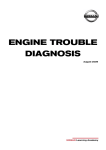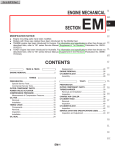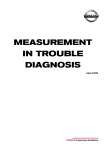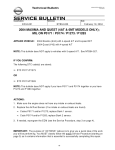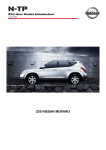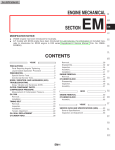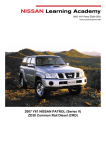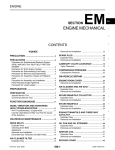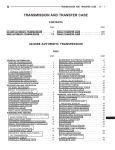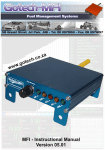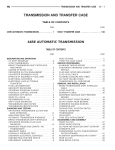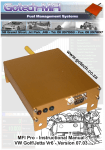Download PETROL ENGINE TROUBLE DIAGNOSIS
Transcript
PETROL ENGINE TROUBLE DIAGNOSIS May 2009 Foreword The information in this Training Manual should not be interpreted as a basis for warranty or goodwill claims against Nissan Motor Co. (Australia) Pty. Ltd. (NMA) unless so designated. This Technical Training Manual is intended for use by NMA & Nissan Dealership Technical Personnel. It is not designed for the use by press or for customer distribution. Before quoting any specifications be sure to check the relevant Service Manual and Technical Bulletins. Right for alteration to data and specifications at any time is reserved. Any such alterations will be advised by Nissan through Technical and Sales Bulletins. ©2009 Nissan Motor Company (Australia) Pty. Ltd. Inc. Victoria Ref: Technical Training Department. Petrol Engine Trouble Diagnosis. Nissan Australia. May 2009. RETURN & RETURNLESS FUEL SYSTEMS Fuel System Pressure Control – Petrol Engine There are two types of fuel supply systems in common use on Petrol engines: • Return Fuel Systems. • Return-less Fuel Systems. It is important to understand the 2 different types of Petrol Engine fuel systems as the pressures will vary between the 2 and there will be slightly different testing procedures employed between these two systems. Return Fuel Systems Since the introduction of electronic fuel injection systems until approx. 2000, all Nissan EFI engines used Fuel Return Systems. These are slowly being phased out as new model engines are introduced. Injector Rail With Injectors NOTE: Y61 TB48DE is the only vehicle that currently uses a Return Fuel System. Intake Manifold Pressure Fuel Damper Pressure Regulator The Pressure Regulator is located on the end of the fuel rail after the last injector and it varies fuel pressure depending on engine load (manifold vacuum). A small vacuum hose connected above the regulator diaphragm keeps the pressure difference between the fuel rail and the manifold constant. This enables consistent injection quantity based only on changes in injector pulse width. Typical fuel pressures are: • At idle, vacuum hose On - 240 kPa • Vacuum hose Off – 290 kPa. This difference in fuel pressure is simply the difference in manifold pressure (vacuum) between engine idle and engine OFF (or at Wide Open Throttle). Once the fuel rail is pressurised, excess fuel continually returns to the tank via the pressure regulator valve. Fuel Damper A fuel damper is usually located at the fuel rail. Some engines may use two fuel dampers. Fuel Filter The fuel filter may be located externally or within the tank with the fuel pump. Refer to the Service Manual for the location. 1 Fuel Filter * Not all models (Vacuum) Pressure Regulator (Varies fuel pressure dependant on manifold vacuum) Fuel Return Fuel Pump (Filter and Sender Unit) * Not all models Fuel Tank Petrol Engine Trouble Diagnosis. Nissan Australia. May 2009. RETURN & RETURNLESS FUEL SYSTEMS Measurement of the Fuel Pressure (Petrol Engines) As part of an Engine no / poor running diagnosis, the Fuel Pressure is an important measurement to record in order to narrow down the cause of a fault. Measuring Fuel Pressure will measure the pressure that the fuel is under prior to entering the injector. Obviously the Fuel won’t spray properly if the pressure is incorrect (too low). Also, the amount of fuel entering the combustion chamber will be insufficient if the pressure is too low (Fuel starvation). If the Fuel Pressure is too high, then the engine will have a rich running / excessive fuel consumption issue Fuel system tests are: • Pressure • Residual Pressure Retention Ensure there is sufficient fuel in the tank before conducting tests. Fuel Pressure Release On all systems, it is important to safely release residual fuel pressure before removing fuel hoses. • Perform “FUEL PRESSURE RELEASE” with CONSULT in Work Support Mode. Ensure that engine stalls and will not restart. • Without CONSULT, remove the fuel pump fuse, run the engine until it stalls and ensure that it will not restart. WARNING: Great care must be taken to avoid fires when opening the fuel system. Fuel Pressure Test on Return Systems 1. Install the Fuel Pressure gauge on the engine. Refer to Section EC – “Basic Service” in the Service Manual 2. Switch Ignition ON. Ensure Fuel Pump activates & then stops after a few seconds. Check for fuel leaks. 3. Start engine and read fuel pressure. Compare to specifications in the Service Manual. Check the following items if fuel pressure is too Low: • Blocked filter or fuel pump pick up • Restricted fuel lines • Faulty pressure regulator. Intake Manifold Pressure Fuel Damper Pressure Regulator NOTE: • If fuel pressure is LOW, carefully squeeze the return line (resulting in blocking it) & watch a sharp & rapid increase to approximately double the normal Fuel Pressure spec. Only do this for a maximum of 3 seconds. If the pressure increase does occur the fuel pressure regulator is faulty. If not, either the level of fuel in the tank is low, the fuel pump output is weak, a fuel line is blocked or the fuel filter is blocked. • If fuel pressure is too HIGH, either the pressure regulator is faulty or the return line is restricted. 2 Fuel Pressure Gauge Fuel Filter * Not all models Fuel Return Fuel Pump (Filter and Sender Unit) * Not all models Fuel Tank Petrol Engine Trouble Diagnosis. Nissan Australia. May 2009. RETURN & RETURNLESS FUEL SYSTEMS Injector Rail With Injectors Return-less Fuel Systems Return-less Fuel systems are easily recognised since they have no fuel return line. They run at a constant pressure that does not change, regardless of engine load. One of the benefits of the Return-less Fuel system is a reduction in fuel tank temperature, which assists in minimising emission of Hydrocarbons from the fuel tank, cap and lines. Less components & improved reliability are other benefits. Fuel Damper Current Models that use a Return-less Fuel system are: K12, C11, J31, J32, N16 with ETC, R51, D40, T30, T31, J10, Z33, Z34, Z50 & Z51. Pressure Regulator The Pressure Regulator is located in the fuel tank at the fuel pump outlet. It maintains fuel pressure typically at 350 kPa. Modern engine management software and feedback from oxygen sensors allows the ECM to maintain correct fuel injection control with this constant fuel pressure. Fuel Pump (Filter and Sender Unit) Pressure Regulator (Pre-set, non variable) Fuel Return Fuel Tank Fuel Damper A fuel damper is usually located at the fuel rail and should not be confused with the old type pressure regulator, as there is no return line or vacuum hose connected to it. The fuel damper is only intended for noise reduction purposes. Some engines may have two fuel dampers located at the fuel rail. Fuel Filter The fuel filter is usually located in the tank with the fuel pump. 3 Petrol Engine Trouble Diagnosis. Nissan Australia. May 2009. RETURN & RETURNLESS FUEL SYSTEMS Fuel Pressure Test on Return-less Systems 1. Install the Fuel Pressure gauge on the engine. Refer to Section EC – “Basic Service” in the Service Manual 2. Switch Ignition ON. Ensure Fuel Pump activates & then stops after a few seconds. Check for fuel leaks. 3. Start engine and read fuel pressure. Compare to specifications in the Service Manual. Injector Rail With Injectors Fuel Damper Check the following items if fuel pressure is too LOW: • Blocked filter or fuel pump pick up • Restricted fuel lines • Faulty pressure regulator. NOTE: • DO NOT SQUEEZE OR CRIMP FUEL LINES! • If fuel pressure is too HIGH, replace the pressure regulator which is located in the fuel tank. Fuel Tank Fuel Pump (Filter and Sender Unit) Pressure Regulator (Pre-set, non variable) Fuel Return Residual Pressure Retention (Both types of Fuel Systems) Ensure that when the engine & fuel pump is switched OFF, fuel pressure is retained in the lines for the specified period. Typically this should be no more than a 10% drop over 10 seconds. If pressure is dropping away excessively, consideration needs to be given to the following items: • Leakage in the reverse direction back to the tank. • Leakage in the forward direction through leaking injectors (or fuel pressure regulator on Return Systems only). If this is the case, the engine will be difficult to start & black smoke will be emitted from the exhaust. Typical SST requirements for Fuel Pressure Testing Adapter KV 101118400 Adapter KV 10117600 AUS Gauge and Adapter 7211 and 7273 Fuel Line Removal Tool 16441 6N210 4 Petrol Engine Trouble Diagnosis. Nissan Australia. May 2009. ELECTRIC THROTTLE CONTROL Electric Throttle Control (ETC) All new petrol engine vehicles are now fitted with Electronic Throttle Control (ETC) systems (fly-by-wire). There is no mechanical connection between the accelerator pedal & the throttle valve on the engine. ETC is a closed loop system that provides the ECM with direct feedback from the Throttle Position Sensor. The ECM will modify the actual throttle valve opening compared to accelerator pedal movement based on various program strategies, including the need to minimise emissions. The benefits of ETC are: • Moving parts are reduced as well as the noise transmission path of a cable. • Integration of idle control, cruise control, traction control and vehicle dynamic control systems. Note: ETC systems have no external means to alter the idle speed. It is controlled directly by the ECM. DO NOT attempt to alter ANYTHING on the throttle body. Mechanical Throttle Control (MTC) The previous system was a very complex one, even though it was mechanically controlled. The actual throttle valve was connected via cable to the Accelerator Pedal & directly operated by the driver. However if there is a change in idle speed required without input from the driver (e.g.: when A/C cuts in), there needs to be a system in place to open an air passage & increase air flow which in turn increases engine speed. Therefore with MTC, air bypass passages are made up to control airflow under certain conditions etc. Numerous combinations of Idle Speed control are required to cope with numerous situations. Therefore this saw the need for numerous passages & idle solenoid devices to be added to the intake manifold / throttle body in order to satisfy all these conditions. 5 Petrol Engine Trouble Diagnosis. Nissan Australia. May 2009. ELECTRIC THROTTLE CONTROL ETC System Components The ETC system consists of: • Accelerator Pedal Position Sensor • Throttle Body with Throttle Actuator Motor • Throttle Position Sensor • ECM and associated wiring. Accelerator Pedal Position Sensor The ECM monitors the Accelerator Pedal Position Sensor to determine the driver’s input. It uses this signal along with its other inputs to determine the amount of throttle opening requested. It contains two potentiometers and the combination of the two signals allows the ECM to calculate an average voltage output from the two. This allows the pedal position to be determined with greater accuracy and reliability than if only a single potentiometer sensor was used. 6 Petrol Engine Trouble Diagnosis. Nissan Australia. May 2009. ELECTRIC THROTTLE CONTROL Throttle Body The Throttle body contains a spring mechanism that holds the throttle valve in a slightly open position (around 10% open). The Throttle Actuator Motor will OPEN or CLOSE the throttle valve from this default position to provide the desired engine speed. The Throttle Actuator Motor is a DC motor that drives the throttle valve through a reduction gear set. It is driven by a Pulse Width Modulation (PWM) signal (also called a varying duty cycle signal). When the ignition is switched OFF, the Throttle Actuator Motor will remain powered for a few seconds to allow it to reposition the throttle valve to the closed position. ECM TPS sends movement signal back to ECM Driver command signal sent to ECM ECM Drives 12V DC MOTOR 7 Motor turns gears & throttle valve Petrol Engine Trouble Diagnosis. Nissan Australia. May 2009. ELECTRIC THROTTLE CONTROL Duty Control Numerous electrical devices are controlled via Duty Control. This can also be referred to as Pulse Width Modulation. This is a simple means of variable current control of a device to any desired speed or position (dependant on the device being controlled such as solenoids or motors). Example; Control of a Simple 12V DC Fan Motor 1. The 1st diagram to the above right shows the Fan Motor controlled (switched) internally via an ECM. It is currently OFF. Therefore it’s rotation speed is 0rpm. 2. The 2nd diagram shows the Fan motor switched to ON. It’s rotation speed is 3000rpm. There are NO resistors in the wiring or switches. It is being fed the full amount of battery power. 3. Here the ECM switches the small switch ON & OFF repeatedly. The switch is ON for 1 second. The switch then goes OFF for another second. Then it goes back to ON for 1 second. Half the time OFF vs Half the time ON means the fan motor only works at approximately half speed. (1500rpm). If the switch was ON for 2 seconds & OFF for 1 second, the fan would rotate at approximately 2000rpm. Obviously the ON & OFF switching will cause a notable speed up & slow down of the motor every 1 second. It’s operation won’t be very smooth. Therefore the ECM switches ON to OFF in smaller increments of time such as Milliseconds to smooth out the operation of the device. 4. The last diagram shows the traditional means of current control via a simple hand operated switch. There are only 3 speed possibilities available; 0rpm. 1500rpm & 3000rpm. Lo speed (1500rpm) is achieved via the current being fed to the motor through a resistor. The Hi speed circuit has no resistor. 8 Petrol Engine Trouble Diagnosis. Nissan Australia. May 2009. ELECTRIC THROTTLE CONTROL ETC Failure Modes Throttle Actuator Motor Should there be a failure of the Throttle Actuator Motor; the ECM will be unable to control the throttle valve. In this case, the internal spring mechanism will provide around 10% throttle opening which will allow the engine to run up to approx. 1,100 ~ 2,000 RPM and be driven to a place of repair. The ECM will still have small amount of control over engine speed. If the Accelerator Pedal Position Sensor is working normally, the ECM will vary the ignition timing (retarding) or injector operation to pull the engine speed lower for idle. When the accelerator pedal is depressed, it will then advance the ignition timing to obtain the full effect of the default 10% open throttle. Accelerator Pedal Position Sensor (APPS) If the ECM cannot receive reliable information from the Accelerator Pedal Position Sensor it will disable the Throttle Actuator Motor so it returns to the default 10% position. Throttle Position Sensor (TPS) If the ECM cannot receive reliable information from the Throttle Position Sensor it will disable the Throttle Actuator Motor so it returns to the default 10% position. Relearning Functions The ECM constructs various self learning functions that are critical to Electronic Throttle Control operation. If the ECM, APPS or TPS connectors are removed OR there are idle concerns, the following procedures MUST be carried out: • Accelerator Pedal Released Position Learning (using ignition key switching) • Throttle Valve Closed Position Learning (using ignition key switching) • Idle Air Volume Learning (using CONSULT). Refer to “Basic Service” in Section EC of the Service Manual for more detail. NOTE: ETC systems are affected by carbon build up at the throttle valve and bore and may require periodic cleaning to restore correct idle performance. Relearning functions MUST also be conducted whenever the throttle is cleaned. 9 Petrol Engine Trouble Diagnosis. Nissan Australia. May 2009. O2 MEASUREMENT Measurement of Oxygen Content after Combustion All modern petrol engines have Oxygen Sensors installed in the exhaust manifold. These sensors generate a voltage signal & sends this voltage back to the ECM. A varying amount of Oxygen seen by the sensor will create a varying voltage signal. The ECM sees this varying voltage & then it MAKES AN ASSUMPTION ON HOW MUCH FUEL ENTERED THE COMBUSTION CHAMBER. If the Oxygen Sensor (O2S) measures a HIGH level of Oxygen; This will tell the ECM the A/F Ratio was LEAN. Therefore on the engines next cycle the ECM will add MORE Fuel. If the Oxygen Sensor (O2S) measures a LOW level of Oxygen; This will tell the ECM the A/F Ratio was RICH. Therefore on the engines next cycle the ECM will add LESS Fuel. Small Amount of Fuel (LEAN) This condition will create a situation where the A/F mix will have a short burn time. There is not enough fuel to make a long burn time. Since the small quantity of fuel has quickly burnt up, the burning will stop & there will be a certain amount of Oxygen remaining amongst the exhaust gases. These gases are expelled out the exhaust valve, the O2 Sensor samples these spent gases & there it will see this remaining O2 content. This will create a voltage signal which indicates to the ECM that the amount of fuel that was sprayed out of the injector was a small amount, therefore next cycle it will increase the injection rate. Large Amount of Fuel (RICH) This condition will create a situation where the A/F mix will have a long burn time. There is now more fuel to make a longer burn time. Since the larger quantity of fuel makes a longer burn time, nearly the entire O2 content will burn. The spent gases left over in the combustion chamber will contain very little if any O2 content. These gases are expelled out the exhaust valve, the O2 Sensor samples these spent gases & there it will see that there is hardly any remaining O2 content. This will create a voltage signal which indicates to the ECM that the amount of fuel that was sprayed out of the injector was a large amount, therefore next cycle it will decrease the injection rate. 10 Petrol Engine Trouble Diagnosis. Nissan Australia. May 2009. O2 MEASUREMENT Ideal Air Fuel Mix (14.7:1) The right amount of Air to Fuel will result in an ideal burn. IDEAL 14.7:1 LEAN by Short Injection Duration (Excess of Air to Fuel) The injector is opened for a short period of time by the ECM. Only a small amount of fuel enters the combustion chamber. This results in a short burn time, therefore some O2 content will be left over after the burning has stopped. This left over content of O2 is expelled & then seen by the O2 sensor. This signals to the ECM that the mix was lean, therefore will result in an increased rate of injection (more fuel) for the next cycle. SMALL INJECTION QUANTITY LEAN by Fuel Starvation (Injection Duration OK) (Excess of Air to Fuel) Due to low fuel pressure / blocked filter / blocked injectors etc, this results in a short burn time due to the lack of fuel. This again results in some O2 content being left over. This left over content of O2 is expelled & then seen by the O2 sensor. This signals to the ECM that the mix was lean, therefore will result in an abnormal increase in the rate of injection for the next cycle in order to compensate for the “lack of fuel” condition. 11 FUEL STARVATION PROBLEM Petrol Engine Trouble Diagnosis. Nissan Australia. May 2009. O2 MEASUREMENT LEAN by Intake Air Leak (un-metered air) (Injection Duration OK - Excess of Air to Fuel) Due to an air leak on the intake (leaking intake manifold gasket, hole in air intake tube etc.) the MAFS sensor only measures a certain amount of air This signal is sent to the ECM, therefore the ECM adds a specific amount of fuel which is relevant to the amount of air measured. Air which is leaking through a hole or a leaky gasket is added to the combustion chamber with an insufficient amount of fuel. Combustion takes place but there is left over O2 in the exhaust gases & therefore is seen by the O2 sensor. This signals the ECM to increase the injection rate above what it thinks is normal. INTAKE AIR LEAK AIR LEAKS!! False LEAN Signal due to Exhaust Leak (Injection Duration OK. Air/Fuel Ratio normal) REMEMBER! If the O2 sensor sees Oxygen, it means LEAN! Therefore if O2 leaks into an exhaust manifold due to a cracked exhaust manifold or a leaking exhaust manifold gasket, the false O2 content will make the ECM increase the injection rate – EVEN IF THE INJECTION RATE WAS PERFECT! EXHAUST MANIFOLD LEAK False LEAN Signal due to Spark Missfire (Injection Duration OK. Air/Fuel Ratio normal) REMEMBER! NO spark means NO burn. Even if TOO MUCH fuel entered the combustion chamber, if it doesn’t burn, neither does the O2 content. Unburnt O2 means LEAN! As a result the ECM increases the injection rate to add more fuel to an engine that doesn’t need anymore fuel. 12 X NO SPARK Petrol Engine Trouble Diagnosis. Nissan Australia. May 2009. O2 MEASUREMENT RICH (Normal Air Quantity with Excess Fuel) If there is an excess amount of fuel added (leaking injectors or excessive injection duration etc.), not all of the fuel will burn because in this case the burning will stop due to all the oxygen being burnt up. RAW FUEL WITHOUT OXYGEN WILL NOT BURN ON IT’S OWN. The excess fuel will be expelled out of the exhaust valve, however the reason why the O2 sensor will indicate RICH is because it cannot sense any O2 in the expelled exhaust gases. NOT because of the raw fuel left over. AN OXYGEN SENSOR CAN ONLY SEE OXYGEN. It cannot see raw fuel. RUNNING RICH / FLOODING Using Air Fuel Alpha in CONSULT II to indicate measured Oxygen Content Display A/F ALPHA in DATA MONITOR or DATA MONITOR (SPEC) CONSULT. If the A/F Alpha shows a reading close to 100%, (typically 95% ~ 105%) then the engine is running close to or at it’s originally programmed map. I.e.; The ECM see no problems with the content of left over O2 it’s measuring in the exhaust gases. The balance of Fuel Quantity to Air Quantity in the engine is normal. Conventional O2 Sensor T30 / K12 / C11 / J10 Constantly switches from 0.1V to 0.9V. Average of 0.5V Wide Band Type 1 R51 / D40 / Z50 / Z33 (6 wire) Ideal = 1.5V RICH = towards 1V LEAN = towards 4V 13 Wide Band Type 2 T31 / Z51 / J32 / Z33 / Z34 (4 wire) Ideal = 2.2V RICH = towards 0.5V LEAN = towards 5V Petrol Engine Trouble Diagnosis. Nissan Australia. May 2009. PETROL ENGINE TROUBLE DIAGNOSIS Check In STEP 1 STEP 2 STEP 2a Verify on the vehicle what the incident is & compare to what is described by the Customer Can’t Fault it? STEP 3 Are there any Fault Codes (DTC’s)? STEP 4a STEP 5a No The fault is basic. FUEL. AIR. SPARK. POWER. GROUND Yes STEP 5b STEP 4b 1. Refer to page in SM that is relevant to the DTC. 2. Inform TechLine of the fault and the actions that YOU have so far carried out & other info gathered if the problem persists. 1. Refer to Symptoms Matrix Chart in the SM in conjunction with the information on the following pages. 2. Inform TechLine of the fault and the actions that YOU have so far carried out & other info gathered if the problem persists. STEP 6 PRIOR TO COMPLETION OF REPAIR AND HANDING BACK TO THE CUSTOMER 1. Go through the checklist on the following page. Consider each item in the list in relation to the problem experienced – REGARDLESS if the problem is there or not! 2. Carry out the “IDLE AIR VOLUME LEARN” (IAVL) operation in “WORK SUPPORT”. Ensure “CMPLT” is achieved. 3. Carry out the “A/F ALPHA” inspection with CONSULT II in “DATA MONITOR (SPEC)” 4. Carry out the “B/FUEL SCHDL” inspection with CONSULT II in “DATA MONITOR (SPEC)” 5. Take vehicle on a thorough road test, re-check for any DTC’s & re-do IAVL on return from road test. (For earlier vehicles, carry out Base Idle, Ignition Timing check / adjust & Mixture Ratio Feedback inspection) 14 Petrol Engine Trouble Diagnosis. Nissan Australia. May 2009. PETROL ENGINE TROUBLE DIAGNOSIS 1. POWER AND GROUND (more detail further on) (a) Battery – Is it charged? Can it hold a charge? Is it being charged? Does it pass a load test? (b) Alternator. Can it cope with high electrical loads? Switch on all accessories & check it’s output under load. (b) Condition of battery terminals? Fusible links are in good condition – terminals clean & tight? (c) Main ground connections are in good condition? (d) Fuses – they are in the correct place & OK? There are typically 3 x different locations where fuses are located. CHECK ALL LOCATIONS! HAS THE VEHICLE GOT DECENT POWER SUPPLY & GROUND CONNECTIONS? 2. FUEL (a) Is there Fuel in the tank? Who was the last to put Fuel in the tank? What kind of Fuel went into the tank? Run engine on known good fresh fuel if in doubt. (b) Fuel Pressure (1) – Measure it with a known good FP gauge & write the figures on the R/O. Measure the FP at idle & again under FULL LOAD. Ensure the tank pick-up, pump, filter, return system (if applicable) is OK. Refer to section EC – Basic Service in the Service Manual. (c) Fuel Pressure (2) – Can the system maintain a residual pressure with the Engine OFF? If the pressure drops away over 20min, where is it going? Back to the tank? Through leaking injectors or fuel pressure regulator diaphragm? Leaking injectors or F-P regulator will contribute to hard start & black smoke emission. 3. IGNITION SYSTEM (a) The CORRECT type of spark plugs for the engine are fitted? (b) Spark plugs are worn / due for replacement? (c) Ignition leads, distributor cap is in good condition? (d) Ignition coil unit, coil power supply, is coil ground connection OK? (A poor coil ground can cause premature coil failures) 4. COMPRESSION (Air) (a) Measure with a known good compression gauge & write the figures on the R/O. Do both a DRY & then followed by a WET compression check. Refer to section EM of the Service Manual for procedure. (b) Air intake system – Are their any air leaks? oil cap, dip-stick, throttle body gasket & bypass hoses, vacuum hoses fitted correctly? (c) Air intake system – Blockage or air flow interference? (d) Air outlet system (Exhaust) – Blockage? Leaking manifold gaskets or cracked exhaust manifold? (e) EGR & crankcase ventilations systems operating OK? 5. ENGINE MECHANICAL TIMING INDICATION SYSTEM (a) CKPS & CMPS signal plates functioning OK / Serviceable? Sensors mounted correctly? Flywheel has been fitted in the correct place? (b) Camshaft / Crankshaft timed correctly? Variable camshaft timing mechanism & timing chain condition OK? 6. ENGINE OIL, COOLANT & PREVIOUS WORK HISTORY HAS THE VEHICLE GOT A DECENT SERVICE HISTORY? (a) Oil level is correct? Is it over/under full? Due for changing? (b) Is it the correct grade / viscosity for the engine? (c) Coolant level & condition is OK? Genuine coolant used? Cooling system is functioning OK? (d) Have you got records of other PREVIOUS WORK HISTORY (Nissan dealer or Non Nissan Dealer), FITMENT OF NON GENUINE PARTS & AFTER MARKET ACCESSORIES? 15 Petrol Engine Trouble Diagnosis. Nissan Australia. May 2009. PETROL ENGINE TROUBLE DIAGNOSIS Checklist Continued 7. NATS All keys start the car OK? Remove keys from key ring set & retry. Ensure there are no other electronic devices that interfere with NATS keys operation when starting. 8. ILLOGICAL INPUTS INTO THE ECM. (a) Whilst being driven as well as stationary, ensure that inputs such as “P/N Posi Sw” & “Brake Sw” are input correctly. For a complete reference list, refer to section B – EC (“TROUBLE DIAGNOSIS – CONSULT Reference Value in Data Monitor Mode”) of the Service Manual. (b) If possible, drive the vehicle fitted with a “KNOWN GOOD” Mass Air Flow Sensor. 9. PRE-PROGRAMMED ECM FAILSAFE OPERATIONS. (a) Ensure the customer does NOT drive with the brake pedal applied. (Specifically on T31 & Z34) (b) Ensure that the brake pedal & brake pedal switches (Stop Lamp & ASCD cut) are correctly adjusted. Ensure the clutch pedal ASCD cut switch is correctly adjusted (where fitted) (c) Ensure the brake lights globes & associated circuit is functioning correctly. Inspect for open circuit brake light globes &/or wiring, connections & grounds are OK. (Specifically on N16 Hatch with ETC). 16 Petrol Engine Trouble Diagnosis. Nissan Australia. May 2009. PETROL ENGINE TROUBLE DIAGNOSIS Basic Service 1. Idle Speed Check With CONSULT, select “ENGINE & then “DATA MONITOR” & view the idle speed by viewing “Engine Speed” in “Main Signals”) 2. Ignition Timing Inspection Given that the engine is installed with a CKPS monitoring the movement & position of the Crankshaft (flywheel) & a CMPS monitoring the movement & position of the inlet camshaft, the ECM has the ability to “see” where the Crankshaft is in relation to the Camshaft & adjust the timing by itself accordingly. Therefore it is NOT necessary to check the ignition timing at normal service intervals etc. HOWEVER, it maybe necessary to inspect the ignition timing as part of a Trouble Diagnosis procedure. If so desired, the actual Ignition Timing can be inspected in the traditional manner to ensure the CKPS & CMPS systems are operating correctly. As shown right, remove No. 1 ignition coil, install Special Service Tool (SST) # E7032 & check the ignition timing. The engine must be idling at operating temperature & ALL accessories OFF. Compare the reading seen by the timing light with the “Ignition Timing” reading in Data Monitor on CONSULT. Typical Scenario’s which may cause the Ignition timing to be out of specification; • The Driveplate / Flywheel has been removed & reinstalled in the wrong place. (1 bolt hole out etc.) • The inlet camshaft variable timing mechanism has jammed in the advanced or retarded position. Typically due the engine oil never being changed. • Foreign object has damaged the sensor pick-up ring on the Driveplate / Flywheel. Remove the starter motor or inspection plate to check inside the bell-housing. • Foreign object / material has damaged / obstructed the camshaft signal plate / sensor. • Idle Air Volume Learn (IAVL) hasn’t “Completed” (CMPLT) • “Target Ignition Timing Adj.” located in “WORK SUPPORT” in CONSULT is incorrectly set. NOTE: Y61 TB48 engines require inspection / adjustment of the ignition timing every 20,000km’s. 17 Only use the Timing Light adapter SST. NEVER use the loop wire in the harness. Petrol Engine Trouble Diagnosis. Nissan Australia. May 2009. PETROL ENGINE TROUBLE DIAGNOSIS Basic Service 3. Accel’r Pedal Released Pos’n Learning & Throttle Valve Closed Pos’n Learning. THIS SIMPLE OPERATION IS CRITICAL! Ensure the time frame suggested above for each key position is observed. “10 sec” means 10 actual seconds on an accurate watch or stop watch. NOT 10 “mini” seconds or 10 “that’ll be right” seconds!! This 2 in 1 learning operation is an EXTREMELY important operation that MUST be carried out for any of the following reasons; • After the Reprogramming of an ECM – BUT BEFORE THE ENGINE IS STARTED!! • A new or substitute ECM is installed in the vehicle. (Along with reprogramming ALL of the NATS ignition keys. Make sure you get ALL THE KEYS from the owner / driver) • A new or substitute Throttle Body Unit is installed on the vehicle. • The existing throttle body unit is cleaned. • Battery power has been lost for a long period of time. • Prior to carrying the Idle Air Volume Learn (IAVL) operation. 18 Petrol Engine Trouble Diagnosis. Nissan Australia. May 2009. PETROL ENGINE TROUBLE DIAGNOSIS Basic Service 4. Idle Air Volume Learn (IAVL) The completion of this operation in around 15 ~ 20 seconds is a good indication that the engine operation is OK. Reasons why the IAVL will not “CMPLT”. • Both Target settings found in “WORK SUPPORT” on CONSULT are not set to “0” • Engine is not at operating temperature. Even though the Engine may feel hot, make sure this temperature is indicated in “DATA MONITOR” on CONSULT. • Engine is too hot (above 90 deg C) • Poor Power Supply to ECM • Bad Ground Connections for ECM • An Electrical Load is ON. (Heater fan, lights, audio) • Switch inputs such as P/N Posi, Power Steering pressure are indicating that the transmission is in Neutral or the Power Steering system is under load. • There is a BASIC ENGINE MECHANICAL problem such as an intake system air leak, compression issues, fuel supply issues or ignition system issues. • The Accelerator Pedal Released Position Learning & Closed Throttle Position Learning has NOT been carried out properly. It may need to be repeated up to 20 times. • Throttle valve isn’t closed properly. Typically excessive carbon is fouling the operation of the throttle unit. 5. Fuel Pressure Check This is for engines that have a “Returnless” type of fuel system only. Ensure that there is a CONSTANT PRESSURE OF 350 kPa AT ALL TIMES - whilst the engine is idling, & under full load. The Fuel pressure should never vary. Check the following items if the Fuel Pressure is too LOW; • Blocked fuel pump pick-up / filter (the fuel filter forms part of the pump assembly) • Restricted fuel lines • Faulty fuel pressure regulator. (The pressure regulator also forms part of the fuel pump assembly) If the Fuel Pressure is too HIGH, replace the fuel pressure regulator. 19 For T31 QR25, carry out the “Closed Throttle Position Learn” procedure. For all other ETC engines, carry out the “Idle Air Volume Learn” procedure. Petrol Engine Trouble Diagnosis. Nissan Australia. May 2009. PETROL ENGINE TROUBLE DIAGNOSIS Basic Service 6. Clearing the “Self Learn” Select “SELF LEARN CONTROL” from the work Support menu & then touch “CLEAR” This operation clears the LONG TERM A/F Alpha values stored in the ECM. This should be carried out after a major engine service or after the repair of an engine running fault. NOTE; • ALPHA reading below 100% (e.g; 75%) indicates that the engine is running TOO RICH • ALPHA reading above 100% (e.g; 125%) indicates that the engine is running TOO LEAN or has a missfire condition (not burning O2). 20 Petrol Engine Trouble Diagnosis. Nissan Australia. May 2009. PETROL ENGINE TROUBLE DIAGNOSIS Basic Service 6. “A/F ALPHA” Inspection 6 cylinder engine displayed. 2 separate banks of cylinders. 4 cylinder has 1 bank. Procedure: 1. Road Test vehicle briskly for 10 km’s. Engine & Transmission should be at operating temperature. 2. Confirm that the IAVL can be successfully completed. 3. Ideally the vehicle should have more than 5000km’s on it. (Vehicle has been properly “run in”). 4. Ensure that the engine has been properly serviced. Ensure the correct grade / type of oil is in the engine & the level is correct. Ensure components such as spark plugs, air filter’s etc are serviceable / genuine parts. Ensure that the correct Part Numbered components have been installed. 5. Ideally the barometric pressure should be 98.3 – 104.3 kPa. 6. Ideally the atmospheric temperature is between 20 – 30 deg C. 7. Engine speed is idling, (The IAVL must have achieved a “CMPLT”). 8. With CONSULT select options in the following order; “ENGINE” – “DATA MONITOR (SPEC)” – “SELECTION FROM MENU” – “A/F ALPHA” (select the 2 of them for a 6 cyl engine. There are 2 banks of cylinders that need to be monitored) – “START”. The screen in the graphic above should now appear. 9. With the engine under the conditions requested in steps 1 ~ 6, what does the black bar indicator do? (i) Does it remain stable & central within the hashed area? (If so, all is OK. See next page for “B/FUEL SCHEDULE” inspection.) (ii) Does it move out of the hashed area below 100%? If so, see next page for “RICH” trouble indication. (iii) Does it move out of the hashed area above 100%? If so, see next page for “LEAN” trouble indication. 21 Petrol Engine Trouble Diagnosis. Nissan Australia. May 2009. PETROL ENGINE TROUBLE DIAGNOSIS A/F ALPHA Indicates “RICH” (Well below 100%) Check the following Items: A/F ALPHA Indicates “LEAN” (Well above 100%) Check the following Items: • Engine Oil is contaminated with excessive fuel or it is the wrong viscosity or overdue for changing. Change engine oil & filter if in doubt. • Air Flow through the air intake is restricted, check for interference of airflow. • Fault with EVAP system (fuel is being drawn directly from fuel tank breathing system & entering inlet manifold.) • Leaking injectors. • Excessively high fuel pressure. • Fuel Pressure regulator is leaking fuel. Fuel entering combustion chamber via the vacuum hose connected to it. (This applies to engines with a return type fuel system only) • Try a known good Mass Air Flow Sensor. • Air Leaks before & after the throttle or in the Inlet Manifold. Gaskets, seals, hoses, cracks etc. • Air Leaks in the Engine. Gaskets, seals, rocker cover, oil cap, dip stick, rear main oil seal etc. • Air Leaks in Exhaust. Manifold gaskets, flange gaskets, cracks etc. • Engine is lacking Fuel. Fuel pressure is too low, pump output is poor, fuel filter / tank pick-up is blocked, hoses kinked / blocked or the pressure regulator not maintaining the pressure correctly. • Cylinder miss-fire due to bad spark. Worn / non genuine spark plug, faulty coil / coil connection / coil ground connection. • Cylinder miss-fire due to bad / no injector operation. (injector dribbling fuel, not spraying). • Interference with the airflow through the air intake. Possible blockage or modified air intake system. • Try a known good Mass Air Flow Sensor 22 Petrol Engine Trouble Diagnosis. Nissan Australia. May 2009. PETROL ENGINE TROUBLE DIAGNOSIS 7. “B/FUEL SCHDL” Inspection (Base Fuel Schedule) Procedure: 1. Road Test vehicle briskly for 10 km’s. Engine & Transmission should be at operating temperature. 2. Confirm that the IAVL can be successfully completed. 3. Ideally the vehicle should have more than 5000km’s on it. (Vehicle has been properly “run in”). 4. Ensure that the engine has been properly serviced. Ensure the correct grade / type of oil is in the engine & the level is correct. Ensure components such as spark plugs, air filter’s etc are serviceable / genuine parts. Ensure that the correct Part Numbered components have been installed. 5. Ideally the barometric pressure should be 98.3 – 104.3 kPa. 6. Ideally the atmospheric temperature is between 20 – 30 deg C. 7. Engine speed is idling, (The IAVL must have achieved a “CMPLT”). 8. With CONSULT select options in the following order; “ENGINE” – “DATA MONITOR (SPEC)” – “SELECTION FROM MENU” – “B/FUEL SCHDL” – “START”. The screen in the graphic above should now appear. 9. With the engine under the conditions requested in steps 1 ~ 6, what does the black bar indicator do? (i) Does it remain stable and central within the hashed area? If so this is OK. See earlier page for “A/F ALPHA” inspection & check. If A/F ALPHA as well as B/FUEL SCHDL is OK, engine condition is normal. (ii) Does it move out of the hashed area below the indicated value? If so, see next page for “Fuel Delivery Increase” inspection. (iii) Does it move out of the hashed area above the indicated value? If so, see next page for “Fuel Delivery Decrease” inspection. 23 Petrol Engine Trouble Diagnosis. Nissan Australia. May 2009. PETROL ENGINE TROUBLE DIAGNOSIS B/F SCHDL Indicates a Fuel Delivery Decrease Check the following Items: B/F SCHDL Indicates a Fuel Delivery Increase Check the following Items: Interference with Air Flow through the intake system: • Restriction of Air-Flow. • Blocked Air Filter. • Modified Air Intake System. Non standard components in Air Intake system have been fitted. • Valve clearances incorrect. • Engine Compression is not to spec. • Try a known good MAFS. Excessive Engine Friction: • High viscosity Engine Oil. Use correct grade of engine oil for the engine. • Engine Oil Level too high. • Engine Oil is overdue for changing. (High viscosity). • Excessive external drive belt tension. • Mechanical fault with engine. (High engine load required to turn engine) • Mechanical fault in Transmission. (High engine load required to drive transmission) Insufficient Combustion: • Valve clearances incorrect. • Valve Timing incorrect. (Correlation between camshaft & crankshaft is incorrect). • Intake Valve Timing Control mechanism fault. (Valve timing advance / retard unit could be jammed). Other: • Interference with the airflow through the air intake. Possible blockage or modified air intake system. • Try a known good MAFS. 24 Petrol Engine Trouble Diagnosis. Nissan Australia. May 2009. ADR 81/01 FUEL CONSUMPTION TEST PROCEDURE THIS LABEL IS FITTED SO THAT THE CUSTOMER CAN COMPARE THE FUEL CONSUMPTION OF DIFFERENT VEHICLE MODELS. IT DOES NOT SUGGEST THE ACTUAL FUEL CONSUMPTION OF THE VEHICLE. ACTUAL FUEL CONSUMPTION OF THE ENGINE UNDER EVERYDAY DRIVING CONDITIONS IS TYPICALLY 15% ~ 34% HIGHER THAN THE FIGURE QUOTED ON THE LABEL. The ADR 81/01 Test Cycle (sourced directly from www.greenhouse.gov.au/fuelguide) The test cycle simulates an 11 km trip with an average speed of 33.6 km/h. Approximately two thirds of the test time simulates urban-stop-go driving where the average speed is 18.8 km/h with the final third of the test drive time being similar to driving on a highway with the vehicle driven to over 100 km/h. The vehicle used in the test exactly matches the vehicle as it appears in the new vehicle brochure. (I.E; NO ACCESSORIES ARE FITTED) 25 Petrol Engine Trouble Diagnosis. Nissan Australia. May 2009. EFFECTS ON PETROL ENGINE FUEL ECONOMY Increased purchasing cost of Fuel. Rising fuel costs are giving the customer the belief that the vehicle is at fault. Especially if the customer adds fuel to the vehicle in set amounts of dollars every week etc. Towing. Roof Racks / Bars. Even though many Nissan vehicles have remarkable towing capacities – the fuel consumption will be greatly affected as a result of towing. Especially if the vehicle is towing something on or close to the maximum towing capacity. If roof racks or bars are fitted (with or without contents) this will greatly effect fuel consumption. Wrong Engine Oil / Poor Service History Modern engines are extremely sensitive to Engine Oil viscosity. Ensure that only Nissan 7.5W 30 engine is used. Irregular servicing will easily cause poor fuel consumption concerns as well. Incorrect Wheels / Tyres. Vehicle is Overweight &/or Modified. Aftermarket accessories Ensure that the original spec wheels & tyres are fitted to the vehicle in question. Increased rolling resistance will cause poor fuel consumption. Additional parts on the exterior of a vehicle such as roof racks and spoilers, or having the window open increases fuel consumption, in some cases by over 20%. Tyre Pressures. Driven in Auto / Lock mode (4WD / AWD). Incorrect Handbrake Adjustment. Ideally, the vehicle should be driven in 2WD at all times unless the road surface conditions are unstable. Ensure that the tyres are set to the correct specification & MAKE SURE the handbrake has NOT been over adjusted. Driveline Friction. Ensure the driveline is properly serviced. Transmission / Transfer / Final drive oils the correct type & are they set to the correct level? Ensure the brakes are not dragging. Driving Style / Driving Pattern. Carefully question the customer on their driving styles / patterns. - Short stop start trips only? - Aggressive driving style vs gentle? 26 EURO III EMISSIONS Euro III – or ADR 79/01 – is a new tailpipe emission level requirement that restricts hydrocarbon emissions to 0.2gm/km, oxides of nitrogen to 0.15 grams per kilometre and carbon monoxide to 2.3 grams per kilometre. Current exhaust emission limits (ADR 79/00 or Euro II) restrict hydrocarbon and oxides of nitrogen emissions to 0.5 grams per kilometre and carbon monoxide to 2.2 grams per kilometre. Under Euro III requirements all new vehicles must meet the new, lower tailpipe emission levels for at least 80,000 kilometres from new. A new condition included in Euro III testing is a more stringent low ambient temperature tailpipe requirement, which entails testing at -7 degrees Celsius. Typical Design Changes & Features Certifying all engines to the new ADR 79/01 (Euro III) generally has been achieved in various ways by vehicle manufacturers as follows; • Upgrade to the catalytic converter (e.g.: split-brick design) or additional catalytic converters. • Upgrades to the existing software in the Engine / Powertrain Control Module (ECM / PCM). • Dual knock sensors • Air Fuel Ratio Sensors (Wide Band O2 Sensors) • Reducing engine idle speed • Electric Power Steering to delete the need for the engine to drive a Power Steer Pump • Increasing the compression ratio (e.g.: from 9.7:1 to 10.3:1) • Changing to a lower viscosity engine oils (e.g.: Change to 5W30 from 10W30) • Optimising valve opening duration via dual independent variable camshaft timing • Adding a 'smart' alternator requiring less engine power • Adding a new fast warm-up transmission oil heat exchanger • Revised shift strategy for automatic transmission and reducing torque converter lockup “ON” speed. (e.g.: reduce the switch “ON” speed by 230 rpm to 1300 rpm) • Reduction of Hydrocarbons via; o Improved sealing of fuel tanks & fuel tank emission (EVAP system) improvements o Improved plastic materials (plastics are a source of hydrocarbons as well) Another major change with the implementation of Euro III is the inclusion of OBD, or On-Board Diagnostics. OBD is an on-board diagnostic system that constantly monitors the emission control system for any possible change in emission performance. If the system monitors any event that results in emissions exceeding the ADR-prescribed OBD thresholds the system 'logs' the event. If a similar event occurs in the same drive or the next drive, the driver is made aware of the two incidents via an indicator light in the dashboard. EURO III EMISSIONS Changes to Nissan vehicles C11 (MR18DE) • All new low friction engine design • Dual HO2S (before & after catalyst) • ECM software calibrated to suit emission requirements • New OBD system (more DTC possibilities) • * Electric Power Steering (deletion of the need to drive a power steering pump) J31 / Z50 / Z33 (VQ35DE) - R51 / D40 (VQ40DE) • 2 x Front O2 sensors changed to Air/Fuel ratio sensors (Wide Band O2 sensors) • ECM software re-calibrated to suit emission requirements • New OBD system (more DTC possibilities) • * CVT (Z50 & J31 only) Note: Z50, R51 & D40 have complied since release. Y61 (TB48DE) • Twin Catalyst Exhaust manifold design. Additional under floor mounted Catalyst (3 x Catalysts in total) • Dual HO2S (before & after catalyst) Now 4 x HO2S. Bank 1 & Bank 2 “Split Control System” – similar to VQ engine. • Additional CKPS for improved OBD performance. (Located in Gearbox housing. Sensor plate forms part of the drive plate) • Ignition system changes (platinum spark plugs) • ECM software re-calibrated to suit emission requirements • New OBD system (more DTC possibilities) • * Deletion of Sub Fuel Tank T30 (QR25DE) • Dual HO2S (before & after catalyst) • ECM software calibrated to suit emission requirements • New OBD system (more DTC possibilities) D22 (VG33E) Petrol variants discontinued * These items have an “indirect” effect on vehicle emissions. They assist with maintaining a vehicles overall performance & fuel economy without impacting on emission performance.






























